This lesson investigates the procedure to find derivatives, such as
![]() ,
,
![]() , and
, and
![]() , for parametric equations x = f(t), y = g(t).
, for parametric equations x = f(t), y = g(t).
The Chain Rule
Suppose a curve is defined by the parametric equations
x = f(t)
y = g(t)
The Chain Rule states that the derivative
![]() for the parametric curve is the ratio of
for the parametric curve is the ratio of
![]() to
to
![]() . Symbolically,
. Symbolically,
 .
.
Finding First Derivatives
The values of the derivatives dy/dt, dx/dt, and dy/dx for a set of parametric equations can be found using the TI-83. Suppose you wish to find the values of the derivatives when t = 0.5 for the parametric equations
y(t) = tan t
Recall that
![]() and that dy/dt represents the rate of change of y with respect to t, dx/dt represents the rate of change of x with respect to t, and dy/dx represents the rate of change of y with respect to x.
and that dy/dt represents the rate of change of y with respect to t, dx/dt represents the rate of change of x with respect to t, and dy/dx represents the rate of change of y with respect to x.
- Define X1T =1/cos(T).
- Define Y1T = tan(T).
Finding Derivatives from a Graph
The derivatives at a point on the graph of a parametric curve can be found by using the derivative features of the CALC menu on the Graph screen.
-
Set the Window values to [0, 2
 , 0.1] x [-3, 3, 1] x [-5, 5, 1] and graph the parametric equations.
, 0.1] x [-3, 3, 1] x [-5, 5, 1] and graph the parametric equations.
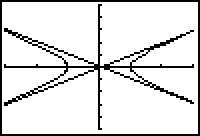
The graph is a hyperbola. The two diagonal lines are not part of the graph. The two lines are similar to the vertical lines that often appear in graphs of functions that have vertical asymptotes.
|
|||
|
|
|||
- Set Tstep to 0.01 and redraw the graph in Dot graphing style.
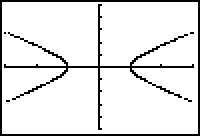
-
Open the CALC menu by pressing
 [CALC].
[CALC].

- Select "2:dy/dx."
The calculator returns to the graph.
- Type 0.5 to enter the value for T.
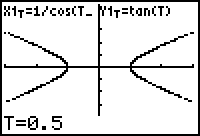
-
Press
 to calculate the derivative.
to calculate the derivative.
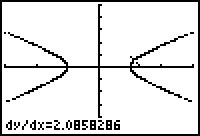
The value of dy/dx at t = 0.5 is approximately 2.0858. That is, the y-values are increasing about 2.0858 times as fast as the x-values.
25.2.1 Use the CALC menu to find the value of dy/dt and dx/dt at t = 0.5. Do these values satisfy the Chain Rule for parametric equations? Click here for the answer.
Finding the Equation of the Tangent Line
The slope of the tangent line is dy/dx
![]() 2.0858. To find the x and y coordinates of the point on the curve when t = 0.5, use the value feature in the CALC menu.
2.0858. To find the x and y coordinates of the point on the curve when t = 0.5, use the value feature in the CALC menu.
- Open the CALC menu and select "1:value."
- Enter 0.5 for T.

The coordinates of the point on the curve when t = 0.5 are approximately (1.1395, 0.5463). Using the point just found and the value of dy/dx for the slope of the line, the equation of the tangent line is
Graph this function parametrically.
- Enter X2T = T.
- Enter Y2T = 2.0858(T - 1.1395) + 0.5463.
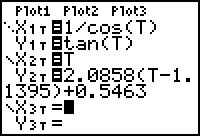
- Display the graphs of the hyperbola and the tangent line at t = 0.5.

25.2.2 Graph the curve given by the parametric equations below and find the equation of the tangent line to the curve when t = 2.
y = 1 - cos(t)
Click here for the answer.